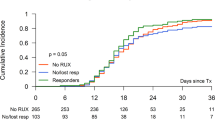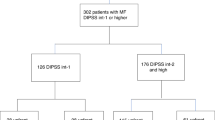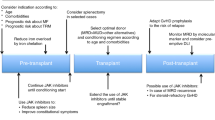Abstract
The Janus-activated kinase 1 (JAK1) and JAK2 inhibitor ruxolitinib is effective in decreasing symptomatic splenomegaly and myelofibrosis (MF)-related symptoms. However, allogeneic hematopoietic cell transplantation (HCT) remains the only curative option. We evaluated the impact of ruxolitinib on the outcome after HCT. A cohort of 14 patients (median age 58 years) received a subsequent graft from related (n=3) and unrelated (n=11) donors after a median exposure of 6.5 months to ruxolitinib. At HCT, MF risk for survival according to the International Prognostic Scoring System was intermediate-2 or high risk in 86% of patients. Under ruxolitinib, MF-related symptoms were ameliorated in 10 (71.4%) patients and the palpable spleen reduced by a median of 41% in 7 (64%) of 11 patients with splenomegaly. Engraftment occurred in 13 (93%) patients. Acute GvHD grade-III occurred in 2 (14%) patients. Median follow-up was 9 months. Survival, EFS and treatment-related mortality were 78.6, 64 and 7%, respectively. Through the anti-JAK-mediated reduction in both cytokines and splenomegaly as well as improvement in performance status, ruxolitinib might improve outcome after allogeneic HCT in patients with MF. The downregulation of inflammatory cytokines might have a beneficial impact on graft failure and acute GvHD.
This is a preview of subscription content, access via your institution
Access options
Subscribe to this journal
Receive 12 print issues and online access
$259.00 per year
only $21.58 per issue
Buy this article
- Purchase on Springer Link
- Instant access to full article PDF
Prices may be subject to local taxes which are calculated during checkout



Similar content being viewed by others
References
Barbui T, Barosi G, Birgegard G, Cervantes F, Finazzi G, Griesshammer M et al. Philadelphia-negative classical myeloproliferative neoplasms: critical concepts and management recommendations from the European LeukemiaNet. JCO 2011; 29: 761–770.
Verstovsek S, Mesa RA, Gotlib J, Levy RS, Gupta V, DiPersio JF et al. A double-blind, placebo-controlled trial of ruxolitinib for myelofibrosis. N Engl J Med 2012; 366: 799–807.
Harrison C, Kiladjian JJ, Al-Ali HK, Gisslinger H, Waltzman R, Stalbovskaya V et al. JAK inhibition with ruxolitinib versus best available therapy for myelofibrosis. N Engl J Med 2012; 366: 787–798.
Horan JT, Logan BR, Agovi-Johnson MA, Lazarus HM, Bacigalupo AA, Ballen KK et al. Reducing the risk for transplantation-related mortality after allogeneic hematopoietic cell transplantation: how much progress has been made? JCO 2011; 29: 805–813.
Cervantes F, Dupriez B, Pereira A, Passamonti F, Reilly JT, Morra E et al. New prognostic scoring system for primary myelofibrosis based on a study of the International Working Group for Myelofibrosis Research and Treatment. Blood 2009; 113: 2895–2901.
Passamonti F, Cervantes F, Vannucchi AM, Morra E, Rumi E, Pereira A et al. A dynamic prognostic model to predict survival in primary myelofibrosis: a study by the IWG-MRT (International Working Group for Myeloproliferative Neoplasms Research and Treatment). Blood 2010; 115: 1703–1708.
Gangat N, Caramazza D, Vaidya R, George G, Begna K, Schwager S et al. DIPSS plus: a refined Dynamic International Prognostic Scoring System for primary myelofibrosis that incorporates prognostic information from karyotype, platelet count, and transfusion status. JCO 2011; 29: 392–397.
Dupriez B, Morel P, Demory JL, Lai JL, Simon M, Plantier I et al. Prognostic factors in agnogenic myeloid metaplasia: a report on 195 cases with a new scoring system. Blood 1996; 88: 1013–1018.
Caramazza D, Begna KH, Gangat N, Vaidya R, Siragusa S, Van Dyke DL et al. Refined cytogenetic-risk categorization for overall and leukemia-free survival in primary myelofibrosis: a single center study of 433 patients. Leukemia 2011; 25: 82–88.
Lange T, Edelmann A, Siebolts U, Kahl R, Nehring C, Jaekel N et al. JAK2 p.V617F allele burden in myeloproliferative neoplasms one month after allogeneic stem cell transplantation significantly predicts outcome and risk of relapse. Haematologica 2013; 98: 722–728.
Bryant E, Martin PJ . Documentation of engraftment and charcterization of chimerism following hematopoietic cell transplantation. In: Blume KG, Forman SJ, Appelbaum FR (eds). Thomas' Hematopoietic Cell Transplantation. Malden, MA, USA: Blackwell Publishing, 2004, pp 234–243.
Tefferi A, Pardanani A . Serious adverse events during ruxolitinib treatment discontinuation in patients with myelofibrosis. Mayo Clin Proc 2011; 86: 1188–1191.
Gupta V, Hari P, Hoffman R . Allogeneic hematopoieticncell transplantation for myelofibrosis in the era of JAK inhibitors. Blood 2012; 120: 1367–1379.
Kroeger N, Holler E, Kobbe G, Bornhauser M, Schwerdtfeger R, Baurmann H et al. Allogeneic stem cell transplantation after reduced-intensity conditioning in patients with myelofibrosis: a prospective, multicenter study of the Chronic Leukemia Working Party of the European Group for Blood and Marrow Transplantation. Blood 2009; 114: 5264–5270.
Alchalby H, Yunus DR, Zabelina T, Kobbe G, Holler E, Bornhauser M et al. Risk models predicting survival after reduced-intensity transplantation for myelofibrosis. Br J Haematol 2012; 157: 75–85.
Ballen KK, Shrestha S, Sobocinski KA, Zhang MJ, Bashey A, Bolwell BJ et al. Outcome of transplantation for myelofibrosis. Biol Blood Marrow Transplant 2010; 16: 358–367.
Bacigalupo A, Soraru M, Dominietto A, Pozzi S, Geroldi S, Van Lint MT et al. Allogeneic hemopoietic SCT for patients with primary myelofibrosis: a predictive transplant score based on transfusion requirement, spleen size and donortype. Bone Marrow Transplant 2010; 45: 458–463.
Gupta V, Kroeger N, Aschan J, Xu W, Leber B, Dalley C et al. A retrospective comparison of conventional intensity conditioning and reduced-intensity conditioning for allogeneic hematopoietic cell transplantation in myelofibrosis. Bone Marrow Transplant 2009; 44: 317–320.
Kerbauy DM, Gooley TA, Sale GE, Flowers ME, Doney KC, Georges GE et al. Hematopoietic cell transplantation as curative therapy for idiopathic myelofibrosis, advanced polycythemia vera, and essential thrombocythemia. Biol Blood Marrow Transplant 2007; 13: 355–365.
Stewart WA, Pearce R, Kirkland KE, Bloor A, Thomson K, Apperley J et al. The role of allogeneic SCT in primary myelofibrosis: a British Society for Blood and Marrow Transplantation study. Bone Marrow Transplant 2010; 45: 1587–1593.
Kroeger N, Alchalby H, Klyuchnikov E, Badbaran A, Hildebrandt Y, Ayuk F et al. JAK2-V617F-triggered preemptive and salvage adoptive immunotherapy with donor-lymphocyte infusion in patients with myelofibrosis after allogeneic stem cell transplantation. Blood 2009; 113: 1866–1868.
Ferrara JL, Levine JE, Reddy P, Holler E . Graft versus-host disease. Lancet 2009; 373: 1550–1561.
Scott BL, Gooley TA, Sorror ML, Rezvani AR, Linenberger ML, Grim J et al. The Dynamic International Prognostic Scoring System for myelofibrosis predicts outcomes after hematopoietic cell transplantation. Blood 2012; 119: 2657–2664.
Landgren O, Goldin LR, Kristinsson SY, Helgadottir EA, Samuelsson J, Bjorkholm M . Increased risks of polycythemia vera, essential thrombocythemia, and myelofibrosis among 24,577 first-degree relatives of 11,039 patients with myeloproliferative neoplasms in Sweden. Blood 2008; 112: 2199–2204.
Ranjan A, Penninga E, Jelsig AM, Hasselbalch HC, Bjerrum OW . Inheritance of the chronic myeloproliferative neoplasms. A systematic review. Clin Genet 2013; 83: 99–107.
Author information
Authors and Affiliations
Corresponding author
Ethics declarations
Competing interests
The authors declare no conflict of interest.
Rights and permissions
About this article
Cite this article
Jaekel, N., Behre, G., Behning, A. et al. Allogeneic hematopoietic cell transplantation for myelofibrosis in patients pretreated with the JAK1 and JAK2 inhibitor ruxolitinib. Bone Marrow Transplant 49, 179–184 (2014). https://doi.org/10.1038/bmt.2013.173
Received:
Revised:
Accepted:
Published:
Issue Date:
DOI: https://doi.org/10.1038/bmt.2013.173
Keywords
This article is cited by
-
The application of JAK inhibitors in the peri-transplantation period of hematopoietic stem cell transplantation for myelofibrosis
Annals of Hematology (2024)
-
The role of JAK inhibitors in hematopoietic cell transplantation
Bone Marrow Transplantation (2022)
-
Impact of prior JAK-inhibitor therapy with ruxolitinib on outcome after allogeneic hematopoietic stem cell transplantation for myelofibrosis: a study of the CMWP of EBMT
Leukemia (2021)
-
Pre-hematopoietic cell transplant Ruxolitinib in patients with primary and secondary myelofibrosis
Bone Marrow Transplantation (2020)
-
Ruxolitinib-based combinations in the treatment of myelofibrosis: worth looking forward to
Annals of Hematology (2020)



